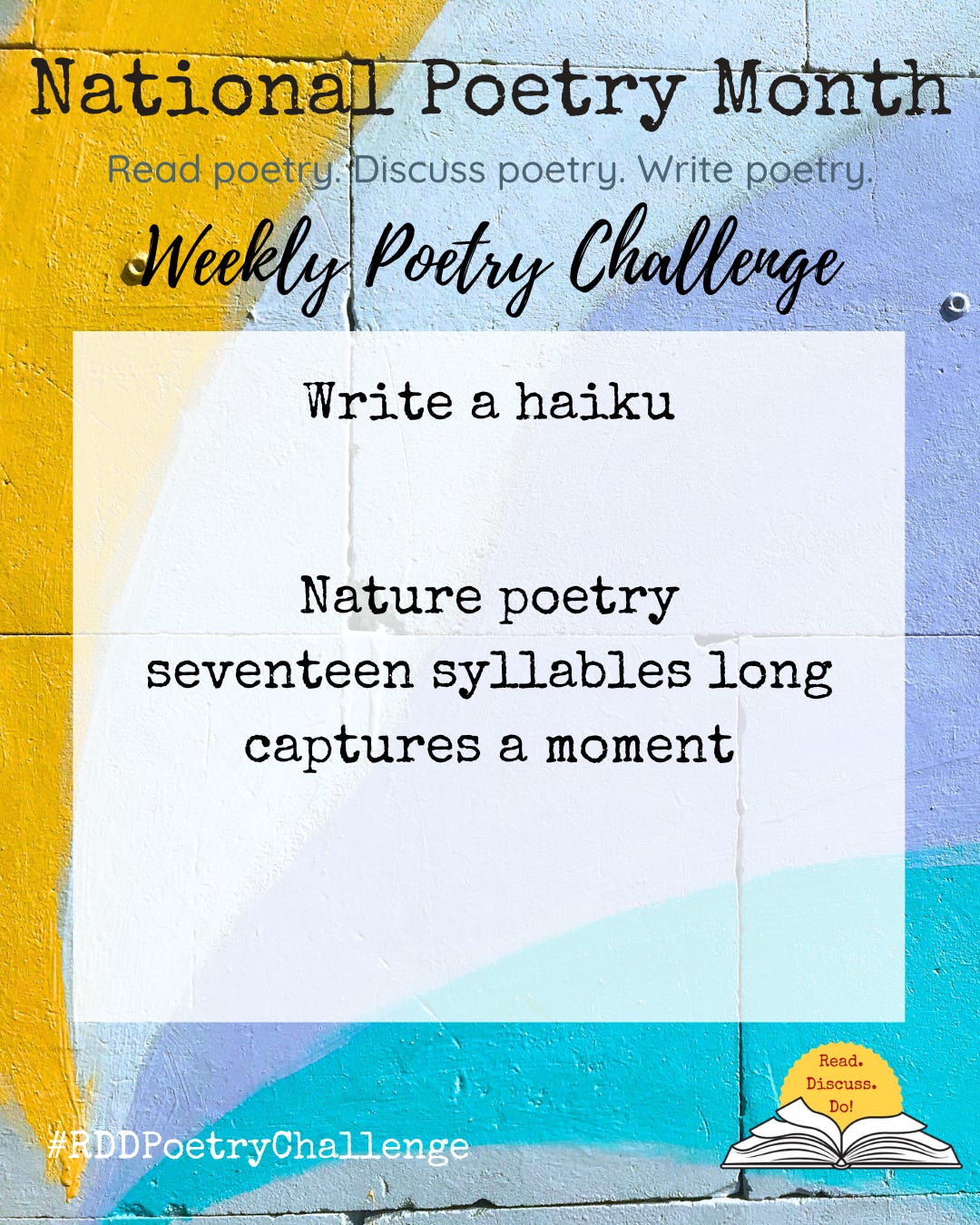Weekly Poetry Challenge Week One
Write haiku with us!
Welcome to Week One of the 2025 Read, Discuss, Do Weekly Poetry Challenge! For this week’s challenge we wanted to visit a form that that gets talked about a lot: haiku!
Haiku is an ancient Japanese form of poetry made famous by the poet Basho. A haiku is a short poem, traditionally 17 syllables long, that captures a moment in nature. Haiku written in English often follows the following formula: Line one is five syllables, line two is seven syllables, and line three is five syllables.
This week we are hoping that you will:
Read: Haiku poems, perhaps choosing from the books listed below.
Discuss:
What do you think of the haiku form?
Had you heard about haiku before?
What do you think might be the most challenging thing about writing haiku?
Do: Write your own haiku!
Haiku are simple enough if you’re primarily focused on the syllable count. But if you’d like to challenge yourself to stay as true to the traditional form as possible, then keep these things in mind:
A haiku is a poem of observation that captures a moment in nature.
The third line of a haiku should include a moment of realization, or what I like to call an “aha!” moment. It can be a punchline, a brief insight, or a reflection that ties the whole poem together. Here are a couple examples from my own writing:
Colorful leaves drift streaming bits of confetti fall’s celebration
In this poem the first two lines describe the falling of autumn leaves, and the third line ties it together with a moment of realization declaring that fall is having a party!
Stand on the rock to avoid Superior waves she has other plans
In this haiku about Lake Superior the third line is meant to be the punchline of a joke. Do you get it?
Haiku Books
Note: Some links will take you to the Read, Discuss, Do bookshop.org storefront. Purchasing a book from the storefront will support independent bookstores and help maintain Read, Discuss, Do at no additional cost to you.
Yuki and the One Thousand Carriers by Gloria Whelan, illustrated by Yan Niscimbene. Yuki and her family must travel a long distance, with one thousand carriers to carry them and their belongings across ancient Japan. Following her teacher’s instruction, Yuki writes a haiku each day of her journey. With beautiful watercolor illustrations, this book is a fascinating look at an ancient culture and one of the poetic forms that it brought to the world.
Wing Nuts: Screwy Haiku by Paul B. Janeczko and J. Patrick Lewis, illustrated by Tricia Susa. This fun book of poems features a collection of senryu, a haiku-like poem that has the same 5-7-5 structure, but focuses on human behavior rather than nature, and often attempts to elicit a laugh. The poems in this book are full of humor and wordplay and are sure to make the reader chuckle. I believe this book is out of print, but you can find used copes at Thrift Books or Amazon, and you should be able to get a copy at your local library!
The Horse’s Haiku by Michael J. Rosen, illustrated by Stan Fellows. A really lovely book, perfect for fans of poetry and horses.
Whoo-ku Haiku by Maria Gianferrari (illustrated by Jonathan Voss) is a story told in a series of haiku. True to the traditional haiku in subject matter, the story is about a family of great horned owls.
Basho and the River Stones by Tim Meyers, illustrated by Oki S. Han. A fictional story about Japan’s most famous poet, Basho, who perfected the haiku form. This story celebrates the life and perspective of Basho in a pleasing story that reads like a folk-tale.
If you or your children/students write haiku this week, we’d love to see them! You can reply to this message, email us, or tag us on Instagram (use the hashtag #RDDPoetryMonth). We will be sharing some readers’ poems in a round-up post at the end of the month, so if you’d like your poems to be considered, please let us know when you send them.
Happy haiku writing!


